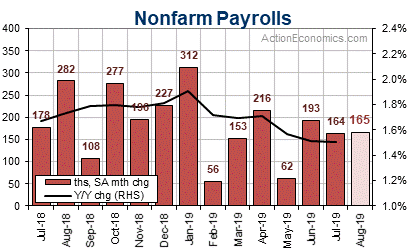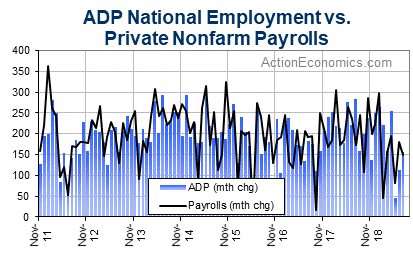Yesterday’s contraction signal from the disappointing US Manufacturing PMI rekindled concerns about the fallout from ongoing geopolitical trade tensions, while this adds further pressure on the upcoming Jobs report on Friday.
The reading was an indication that trade and tariff turmoil continues to cast a dark shadow over the global economy. The US ISM manufacturing index dropped to 49.1 in August, weaker than expected, but not a surprise, after slipping 0.5 ticks to 51.2 in July. This is the first time in contractionary territory since August 2016, and it is the lowest since January 2016. Every component but supplier delivers is now below the 50 expansion, contraction line. Meanwhile, the Markit manufacturing PMI slipped as well, printing the lowest outcome since September 2009, as it holds above the contraction line.
Significant is the fact that the employment sub-component fell to 47.4 from 51.7. This could be a negative singal for the upcoming jobs report from US on Friday, as a possible contraction in manufacturing sector may result to cut the number of Jobs in the particular sector.
However, let’s flip back to the Non-Farm payrolls report which is expected to post a rise up to 165k in August after the in-line outcome seen last month with a 164k increase. This forecast is well below the 223K seen in 2018.
The jobless rate ticking down to 3.6%, alongside gains of 0.3% for both hours-worked and hourly earnings. Initial claims remained firm in August, while most consumer confidence eased to still firm levels. Most producer sentiment measures rebounded slightly, but vehicle assemblies could moderate from an elevated June-July pace.

FX Markets so far today:
The Dollar has traded mostly softer, although making gains against an underperforming Yen. The Pound continued to charge higher, extending the rebound from yesterday following news that opposition and Tory party rebel members of parliament had successfully wrested control of the House of Common’s agenda, paving the way for a vote later today on a bill that would stop a no-deal from happening on October 31.
Cable posted a high of 1.2220, the culmination of a 2% rally from yesterday’s 35-month low at 1.1958 (not including the flash-crash lows seen after the Brexit vote in 2016).
Elsewhere, EURUSD extended a rebound that commenced yesterday after the pair hit a 28-month low at 1.0926, rising to three-session high terrain above 1.1020 today. Sub-forecast US ISM and PMI survey data yesterday was followed by an unexpected upward revision in final Eurozone services and composite PMI data today.
The Yen took a rotation lower amid a risk-back-on sentiment. USDJPY lifted to around 106.20-25 from sub-106.00 levels, while AUDJPY saw a more pronounced advance. Above-forecast Caixin China services and composite PMI survey readings provided tonic to nervous markets, offset to the ill effects of yesterday’s worrisome US data. This sparked a stock rally on Chinese bourses, and saw European equities and USA500 futures rally.
ADP Survey
The 156k July ADP rise nearly matched 160k private BLS payroll estimate with a 170k total BLS payroll increase. A boost was seen in the June ADP rise to 112k from 102k that narrowed the gap to the 191k private payroll increase for that month.

The upside bias for the initially reported ADP figures since 2016 has diminished over the last year, though we still have a 192k average “as reported” ADP gain over the 12 months through June that is above the 183k average BLS private payroll gain. The average “as reported” ADP overshoot is 15k per month if we extend the average back to the methodology change of October 2016. We saw ADP “as reported” undershoots of -89k in June and -56k in May but an 80k overshoot in April.
The ADP as-reported average absolute error since the 2016 methodology change is 63k, versus a 59k average absolute error for the survey median. Since the methodology change back in 2012, the respective figures are 58k and 51k, and since the change in 2008 the figures are 73k and 54k.
Click here to access the Economic Calendar
Andria Pichidi
Market Analyst
Disclaimer: This material is provided as a general marketing communication for information purposes only and does not constitute an independent investment research. Nothing in this communication contains, or should be considered as containing, an investment advice or an investment recommendation or a solicitation for the purpose of buying or selling of any financial instrument. All information provided is gathered from reputable sources and any information containing an indication of past performance is not a guarantee or reliable indicator of future performance. Users acknowledge that any investment in Leveraged Products is characterized by a certain degree of uncertainty and that any investment of this nature involves a high level of risk for which the users are solely responsible and liable. We assume no liability for any loss arising from any investment made based on the information provided in this communication. This communication must not be reproduced or further distributed without our prior written permission.



















